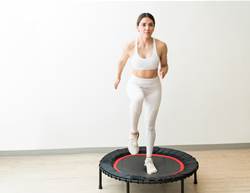It finally happened. You went back to the gym after months of debating it, and your first workout felt great. The sweat was flowing, the endorphins kicked in. But the next morning? You woke up sore in all the areas you’d targeted. Now, even the idea of lifting another weight or hopping on the treadmill feels painful. So, what’s the best move? Should you work out when sore or take a break?
It’s tempting to let soreness throw your routine off track. But the old saying “no pain, no gain” might actually hold some truth. Below, fitness experts break down how to handle muscle soreness—when to push through it and when to rest.
What is muscle soreness?
Muscle soreness is discomfort, tenderness or stiffness caused by micro-tears to the muscle fibres, explains performance physiologist Carson Gantzer. These micro-tears often result from eccentric exercises that forcibly lengthen muscles, he adds. And while the term “micro-tears” might sound alarming, this small-scale damage is actually a normal and necessary part of muscle adaptation and growth.
This soreness can range from mild and short-lived to more prolonged, which is referred to as delayed onset muscle soreness—or DOMS—adds certified strength and conditioning specialist and instructor Alexander Rothstein.
DOMS can feel like anything from general stiffness to sharp, limiting pain depending on how hard you trained, Rothstein explains. It’s still not entirely clear why soreness sets in hours after a new or intense workout, “but it’s believed to result from structural damage to the muscle and cell membranes” due to excess strain. This then triggers inflammation, which activates pain receptors and leads to swelling. That’s why, after an intense lower-body session, something as simple as sitting down can feel like a mission.
Thankfully, this type of soreness “is completely normal” after a workout, says physical therapist Kristina Welsome. “It happens to all of us at some point—usually when starting exercise for the first time, after a long break, when trying a new type of workout, or when pushing past a plateau,” she says.
What does muscle soreness feel like?
“Muscle soreness is classified as a muscle strain and is perceived as stiffness, aching or tenderness,” says Rothstein. Depending on which muscle groups you worked most recently, you might find it hard to do everyday movements like lowering yourself into a chair or reaching up to open a cupboard.
Should I work out when sore?
DOMS is your body’s natural response to the good kind of stress (called eustress) that comes from a challenging workout, Welsome says. That means it’s not always a bad thing. It’s actually your body rising to the challenge and building resilience—and the best way to move through it is to keep moving, she adds.
With time and consistency, you’ll reach a point where you feel minimal or no pain after each workout, Welsome says. That’s the goal. “The best way to treat DOMS is to prevent it by maintaining regular physical activity rather than falling into a sedentary lifestyle,” she explains.
That said, pain and soreness exist on a spectrum. There’s definitely a time for rest and recovery—especially before tackling leg day again. It’s all about balance. “Movement supports repair and recovery, but it needs to be at a low enough intensity so it doesn’t cause further damage,” Rothstein says. “Research shows that movement can also reduce the perception of pain, especially the pain triggered by stretching or engaging sore muscles.”
How to work out when sore
“If you’re feeling stiff or sore in the muscles you trained, the best approach is to respect what your body’s telling you,” says Welsome. The worst thing you could do is go too hard again—or not move at all. Instead, she recommends alternating your workouts each day to avoid DOMS and prevent inactivity.
For example, mix up strength training or high-intensity exercise with lower-impact aerobic workouts like swimming, cycling or a brisk walk. Mobility-based movement like yoga or tai chi can also help, Welsome says. “There’s no one-size-fits-all solution, but mixing up your training style, intensity and duration is a smart way to hit your goals without hurting yourself.”
How to recover from muscle soreness
Here are a few strategies to help your body bounce back after pushing it a bit too far:
Never skip warming up
Before getting back into it, start with low-intensity dynamic movements like walking, cycling or gentle stretching to improve circulation and prep your muscles, Rothstein says.
Stay fueled
“Make sure you stay hydrated and eat a nourishing meal—your body needs those nutrients to recover and rebuild,” Welsome advises.
Massage or foam roll
Using a foam roller or massage gun can help ease tension, says Welsome.
Temperature therapy
“Plenty of people swear by hot showers, saunas, Epsom salt baths or cold plunges,” Welsome says. “There’s both anecdotal and research-backed evidence to support hot or cold therapy, depending on what feels best for you.”
Sleep
Quality rest is essential for muscle repair and overall recovery, Welsome stresses.
Avoid pain-killers if you can
It’s tempting to reach for ibuprofen when your legs are too sore to bend, but Rothstein warns against it. These “can blunt the muscle repair process and mask pain,” which may lead you to overtrain and cause more harm in the long run.
When to be concerned about muscle soreness
If soreness lasts more than three or four days or gets worse instead of easing up, it could signal an injury. In that case, it’s time to see your GP or physio, Welsome says. If you’re managing an existing injury and feel burning or shooting pain, stop your workouts and seek professional guidance.









